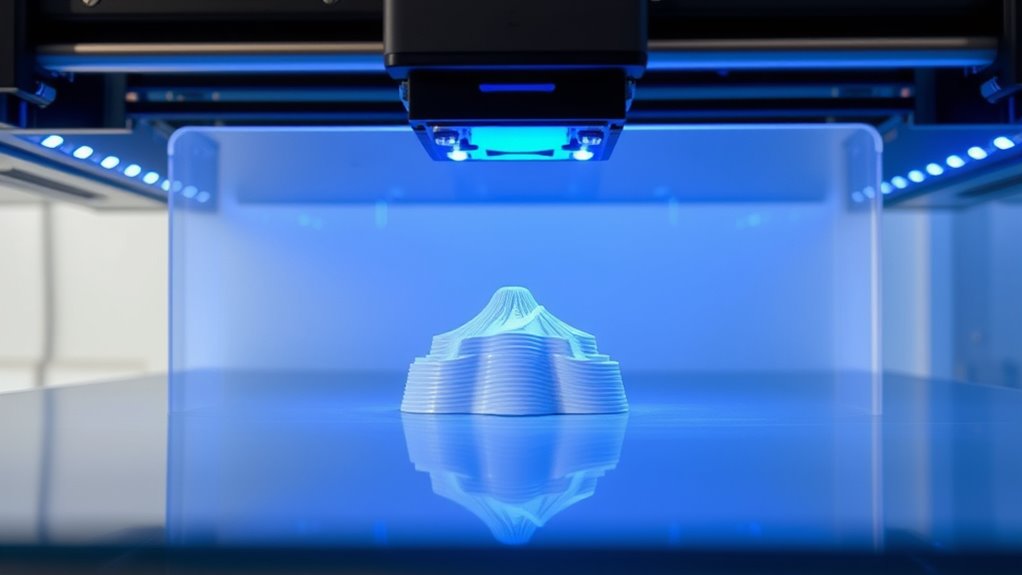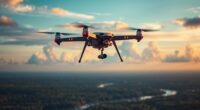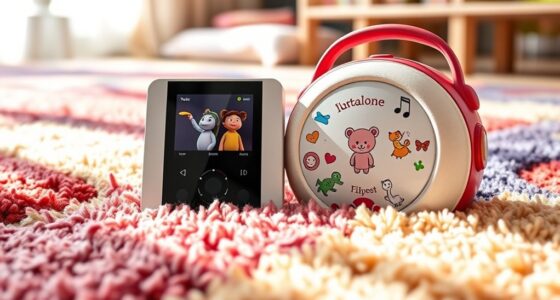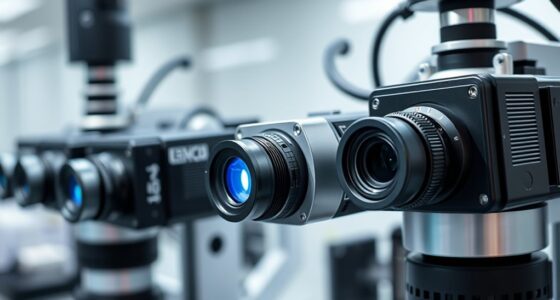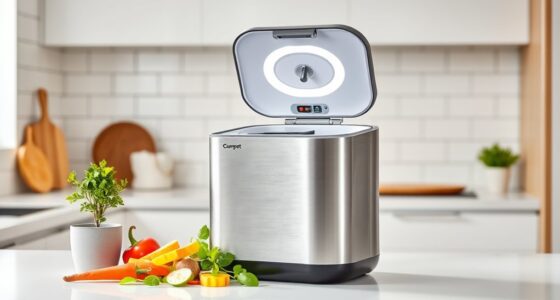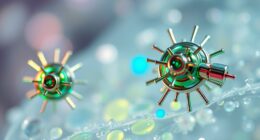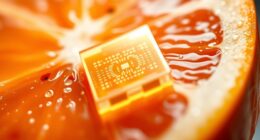If you’re searching for the best SLA printers for microfeatures in 2025, you’ll want models that combine top-tier precision with detailed resolution. I recommend focusing on devices that support high accuracy, fine layer control, and superior surface finish. From hobbyist to industrial levels, there are options for every need. Keep exploring—there are key features and specific models that can help you achieve the intricate detail you’re after, and I’ll show you what to look for next.
Key Takeaways
- High-resolution SLA printers in 2025 deliver microfeature detail with resolutions often below 50 microns.
- Many models feature advanced optical systems for ultra-precise layer curing and minimal layer lines.
- Automated calibration and resin handling improve consistency and ease of use for intricate microfabrication.
- Compact, desktop SLA printers now support larger build volumes without sacrificing micro-detail quality.
- Industry leaders focus on faster print speeds and improved surface finishes, ideal for microengineering and jewelry applications.
ELEGOO Neptune 4 Plus 3D Printer
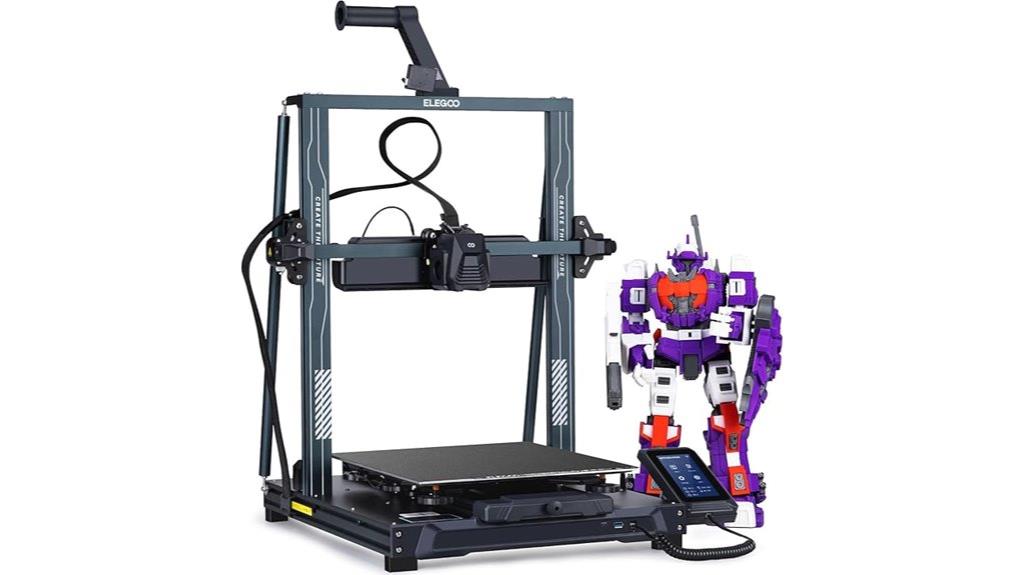
If you’re looking for a versatile and high-speed resin alternative that can handle detailed microfeatures, the ELEGOO Neptune 4 Plus 3D Printer is an excellent choice. It boasts speeds up to 500mm/s with default 250mm/s, supported by Klipper firmware, and accelerations of 12,000mm/s², enabling rapid, precise prints. Its large build volume (320x320x385mm) lets you create bigger models or multiple objects at once. Features like auto calibration, pressure advancing, and input shaping minimize vibration, ensuring detailed, high-quality results. With a powerful direct drive extruder and support for various filaments, it’s reliable and easy to operate, perfect for demanding microfeature work.
Best For: hobbyists, beginners, and professionals seeking a high-speed, large-volume 3D printer capable of detailed, high-quality prints with reliable performance.
Pros:
- Supports lightning-fast printing speeds up to 500mm/s with high acceleration for rapid production
- Large build volume (320x320x385mm) suitable for big models or multiple objects in one print
- Equipped with automatic calibration features like input shaping and pressure advancing for precise, high-quality results
Cons:
- Setup instructions are not fully detailed, requiring users to research and familiarize themselves with calibration procedures
- Some users report WiFi connectivity issues and occasional software faults, such as print resume failures
- Manual bed leveling and calibration are necessary for optimal performance, which may be challenging for complete beginners
Oki Microline 320 Turbo/N Dot Matrix Printer
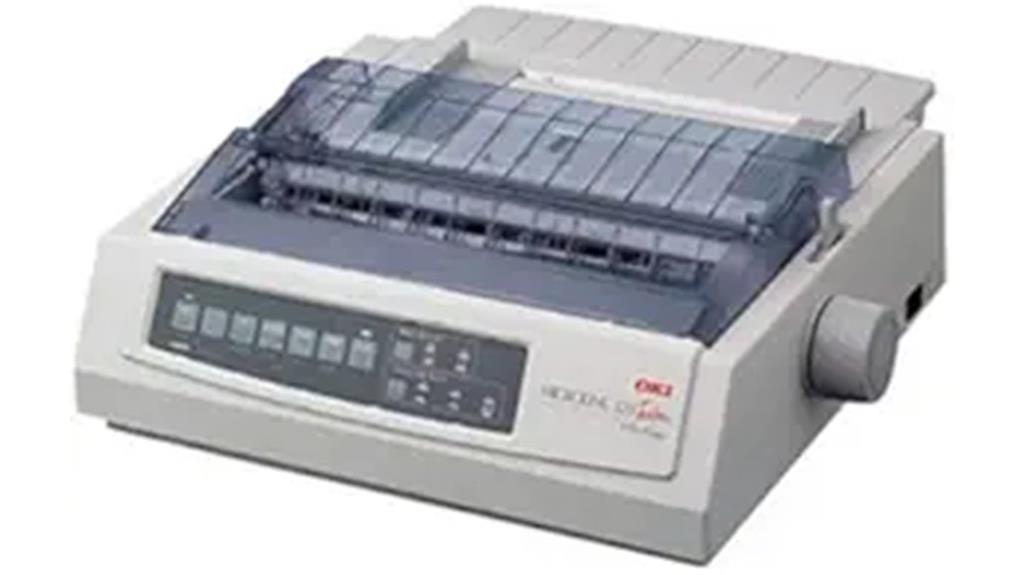
The Oki Microline 320 Turbo/N Dot Matrix Printer stands out as a reliable choice for high-demand industrial environments that require consistent, durable printing. With a speed of 435 characters per second and a resolution of 240 x 216 dpi, it handles large volumes efficiently. Built for demanding settings like warehouses, retail, and manufacturing, it boasts Tank-Tough reliability, running twice as long as similar models. Its network-ready design, including USB and high-speed print server, ensures seamless integration. Though it doesn’t support duplex printing, its rugged construction and ease of use make it ideal for continuous, high-volume tasks in challenging environments.
Best For: high-volume industrial environments such as warehouses, manufacturing plants, and retail POS systems requiring reliable, durable dot matrix printing.
Pros:
- Exceptional durability with Tank-Tough reliability for long operational hours
- High-speed printing at 435 cps with crisp 240 x 216 dpi resolution
- Seamless network integration via high-speed print server and USB interface
Cons:
- Does not support duplex or dual-sided printing capabilities
- Heavier and bulkier design, weighing approximately 16.8 pounds
- Limited to monochrome (black-and-white) output, with no color printing
Tina2S 3D Printer with WiFi and Auto-Leveling
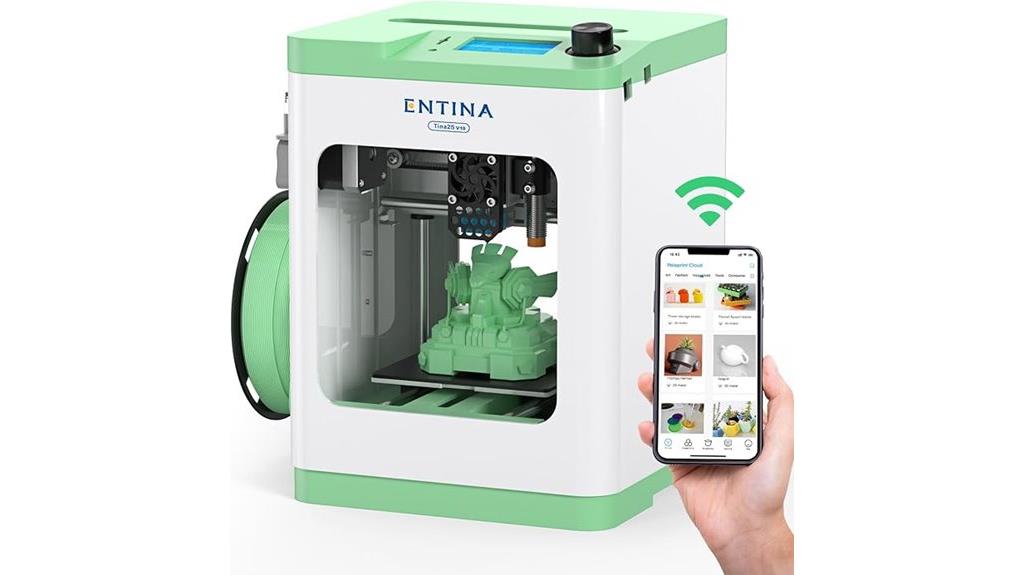
For beginners, kids, and those seeking a hassle-free 3D printing experience, the Tina2S 3D Printer with WiFi and Auto-Leveling stands out as an ideal choice. It arrives fully assembled, ready to print straight out of the box, making setup effortless. Its compact design fits easily into home, school, or office spaces, and the built-in LED light allows real-time monitoring. With advanced auto-leveling, there’s no manual calibration needed, ensuring perfect first layers. The printer supports multiple control methods via app, USB, or slicing software, and boasts high-precision prints at 0.04mm resolution, all while operating quietly for a seamless experience.
Best For: beginners, kids, educators, and anyone seeking an easy-to-use, compact 3D printer with minimal setup and reliable performance.
Pros:
- Fully assembled and ready-to-use out of the box, ideal for ease of setup.
- Auto-leveling feature eliminates manual calibration, ensuring perfect first layers.
- Supports multiple control methods (app, USB, slicing software) and provides high-resolution prints at 0.04mm.
Cons:
- Limited build volume due to its compact size.
- May require additional troubleshooting for advanced customization.
- High-speed printing at 200mm/s might affect detailed quality depending on model complexity.
Canon PIXMA MG3620 Wireless All-in-One Color Inkjet Printer
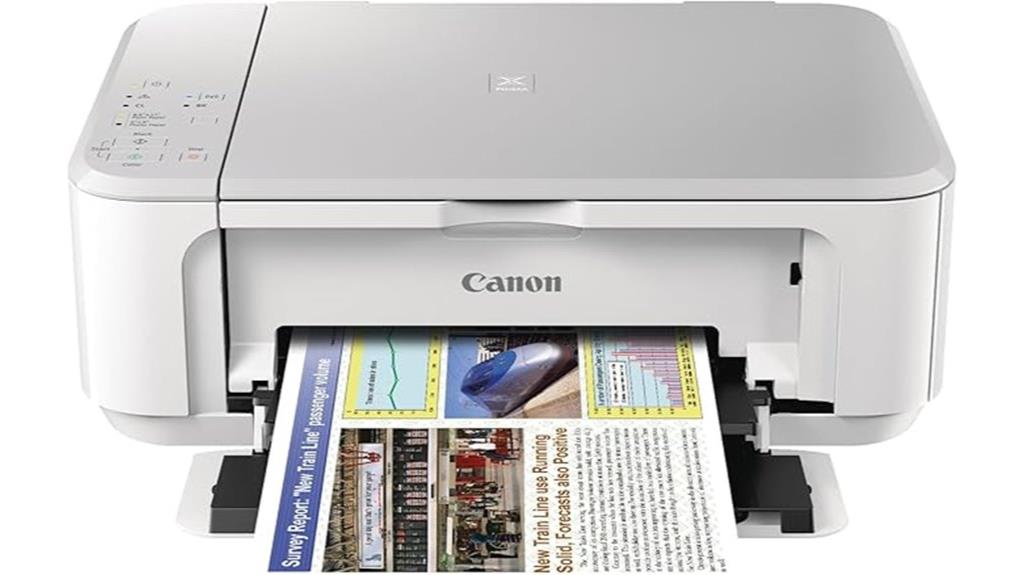
The Canon PIXMA MG3620 stands out as a versatile choice for home users and small offices seeking reliable, high-quality color printing without breaking the bank. This wireless all-in-one inkjet printer offers scanning and copying features, supporting mobile printing via AirPrint, Google Cloud Print, NFC, and Canon Print app. It handles media up to 8.5 x 14 inches with a 100-sheet capacity. With resolutions up to 4800 x 1200 dpi, it produces sharp images and text. Its compact design, lightweight build, and affordability make it ideal for light-duty tasks. While ink costs can be high, its ease of use and strong connectivity features earn it positive reviews for everyday printing needs.
Best For: home users and small offices seeking an affordable, reliable wireless all-in-one printer for light-duty color printing, scanning, and copying tasks.
Pros:
- Easy wireless setup and seamless mobile device printing support
- Compact, space-saving design suitable for small spaces
- Good print quality with sharp, vibrant images at 4800 x 1200 dpi
Cons:
- High ink costs and limited initial ink supply (~50 prints)
- Occasional paper jams and connectivity resets reported by users
- Basic scanning features with some software complexity and limited advanced options
Canon PIXMA TR4720 Wireless All-in-One Printer
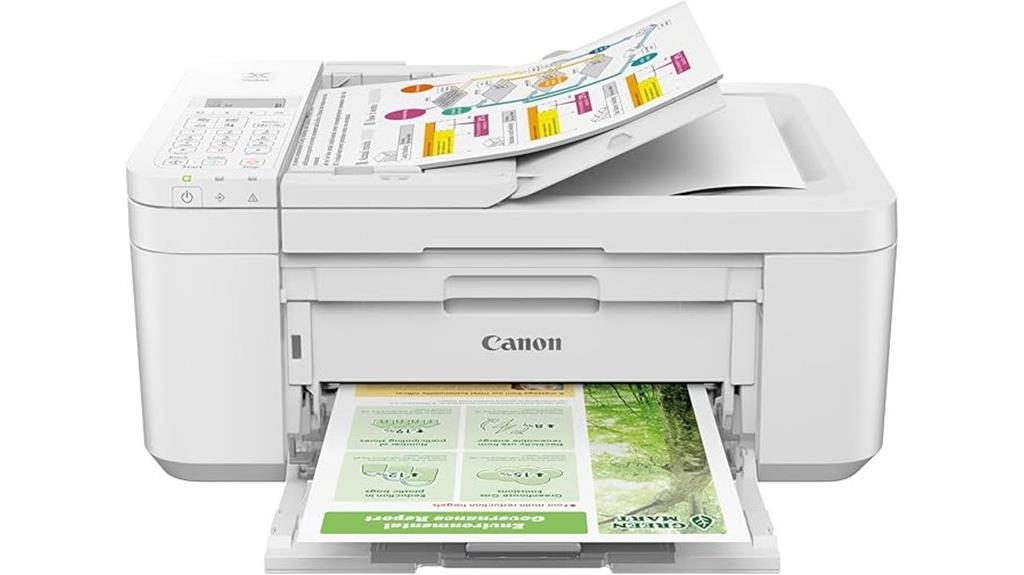
If you need a versatile, budget-friendly printer for light home or office tasks, the Canon PIXMA TR4720 fits the bill. It’s a 4-in-1 wireless all-in-one that handles printing, copying, scanning, and faxing. With support for auto duplex printing and a 100-sheet paper tray, it’s convenient for everyday use. The device produces decent photo and document quality, though colors may fade slightly. Easy to set up via the Canon PRINT app, it’s compatible with Mac, Android, and iOS devices. While it’s reliable for occasional printing, its manual duplexing and limited ink capacity mean it’s less suited for high-volume tasks.
Best For: individuals seeking an affordable, all-in-one wireless printer for light home or office tasks with occasional printing needs.
Pros:
- Easy to set up and compatible with multiple devices including Mac, Android, and iOS
- Supports auto duplex printing and has a 100-sheet paper tray for convenience
- Produces decent quality documents and photos suitable for everyday use
Cons:
- Limited ink capacity requiring frequent cartridge replacements
- Manual duplexing can be time-consuming due to the lack of automatic double-sided printing
- Outdated software and potential mechanical reliability issues over time
RENEWED IM C4500 Color Laser Multifunction Copier
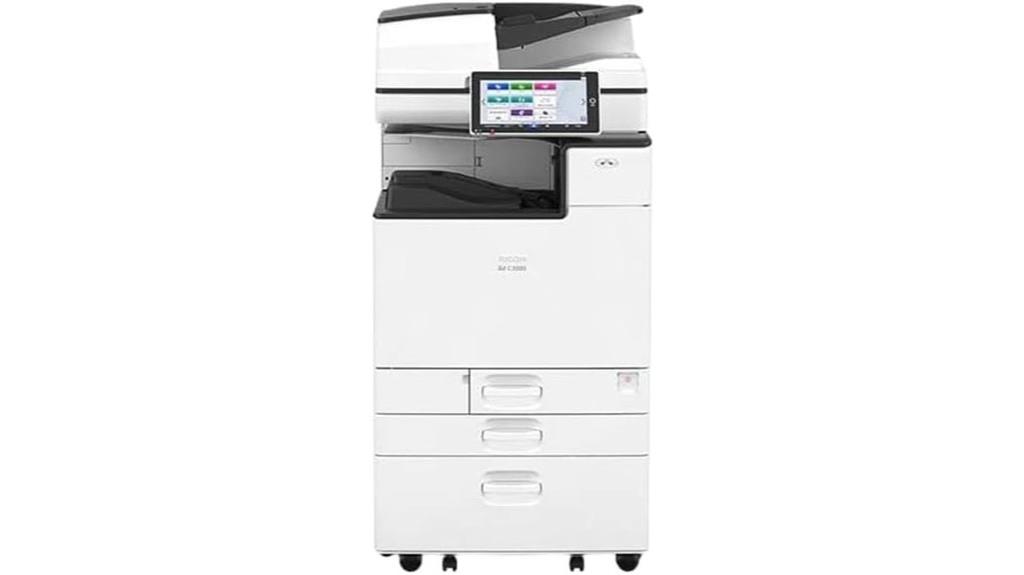
With its rapid print speed of up to 45 pages per minute and robust paper handling capabilities, the Renewed Ricoh IM C4500 Color Laser Multifunction Copier stands out as an excellent choice for busy offices needing reliable, high-volume color printing and copying. It offers all-in-one functionality, including scanning, faxing, and duplex printing, with support for media up to 12.6 inches wide and 11×17 inches. The device features a high input capacity of up to 4,700 sheets, 600 x 600 dpi resolution, and easy online updates through Ricoh’s ACT platform. Professionally inspected, it looks and works like new, backed by a 90-day guarantee.
Best For: busy offices and workgroups requiring high-volume, reliable color printing and copying with all-in-one multifunction capabilities.
Pros:
- Rapid print speed of up to 45 pages per minute for efficient workflow.
- Large media handling with support for up to 4,700 sheets and media sizes up to 11×17 inches.
- Easy online updates via Ricoh’s ACT platform ensure the device stays current with new features.
Cons:
- Size and dimensions (23 x 27 x 37.9 inches) may require ample space in the office.
- As a renewed product, there may be minor scratches or dents present.
- Accessories may not be original, which could affect compatibility or aesthetics.
HP OfficeJet 250 Portable All-in-One Printer with Wireless & Mobile Printing
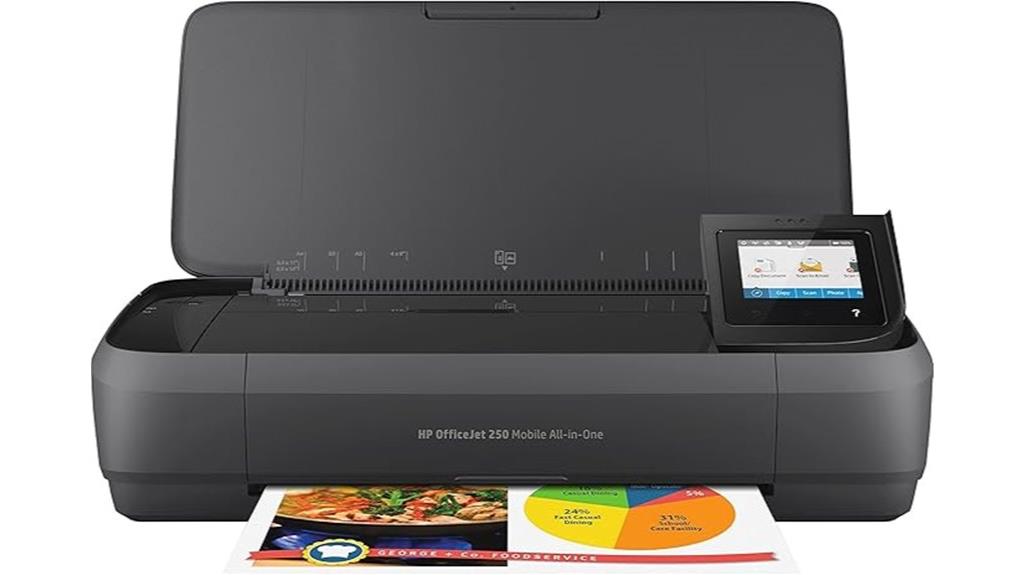
For mobile professionals needing reliable printing on the go, the HP OfficeJet 250 Portable All-in-One Printer stands out thanks to its compact design and versatile wireless connectivity options. It offers printing, scanning, and copying in a durable, lightweight package that fits easily into bags or briefcases. With support for Bluetooth, Wi-Fi Direct, and HP Auto Wireless Connect, setup is quick and straightforward. The device includes a rechargeable battery with fast charging, making it perfect for remote work. Its high page yields, support for various media types, and crisp output make it a versatile, dependable choice for on-the-move productivity.
Best For: mobile professionals, telecommuters, and occasional home users seeking a portable, versatile printer with reliable wireless connectivity.
Pros:
- Compact, lightweight design ideal for on-the-go use
- Supports multiple wireless connections including Bluetooth and Wi-Fi Direct
- High page yield cartridges and long battery life for extended productivity
Cons:
- Connectivity issues with Mac OS, including job stalls and recognition problems
- Small touchscreen can be difficult to navigate and prone to scratches
- Slow print speed and high ink consumption for frequent printing needs
iDPRT Inkless Portable Printer for Travel and Office
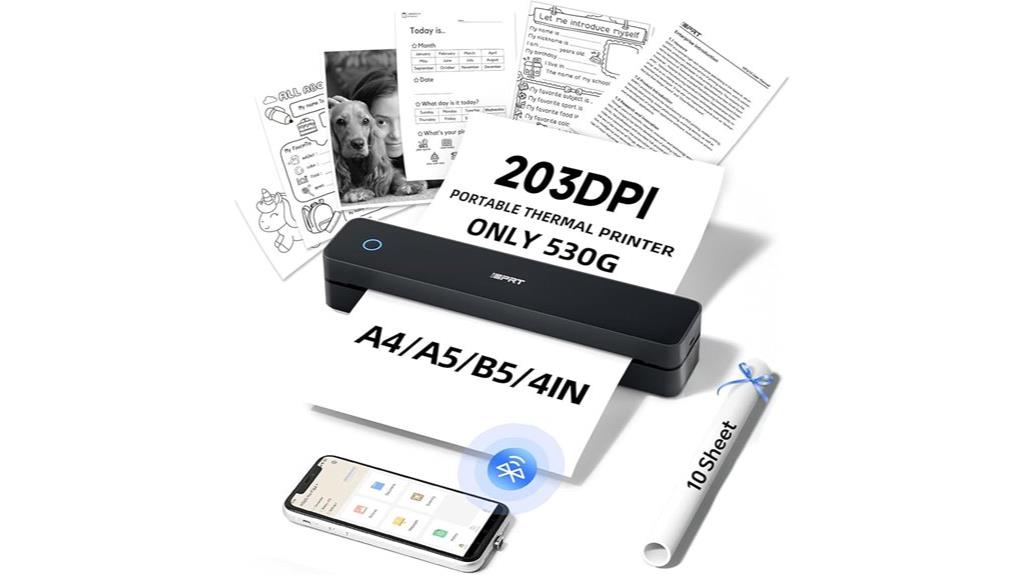
The iDPRT Inkless Portable Printer stands out as an ideal choice for busy travelers and office workers who need quick, reliable printing on the go. Weighing just 530 grams, it supports media sizes up to 8.5 x 11 inches and connects seamlessly via Bluetooth or USB to laptops, smartphones, or tablets. Its inkless thermal technology delivers sharp, clear black-and-white prints at 203 dpi, perfect for small documents, labels, or photos. The compact design, along with a rechargeable 2000mAh battery, makes it highly portable. While it excels in convenience, it’s best suited for single-page printing, with occasional connectivity or battery life issues.
Best For: busy travelers and office workers who need quick, portable, and reliable printing for small documents, labels, or photos on the go.
Pros:
- Compact and lightweight design makes it highly portable and easy to carry.
- Supports multiple media sizes up to 8.5 x 11 inches, suitable for various printing needs.
- Inkless thermal technology provides clear, sharp black-and-white prints without the hassle of ink cartridges.
Cons:
- Primarily supports single-page printing, making multi-page documents difficult to print efficiently.
- Occasional connection stability issues with Bluetooth or USB can disrupt printing.
- Battery life may vary, potentially limiting continuous use during extended tasks.
XMINI Handheld Inkjet Printer, Portable Mini Inkjet Coding Machine
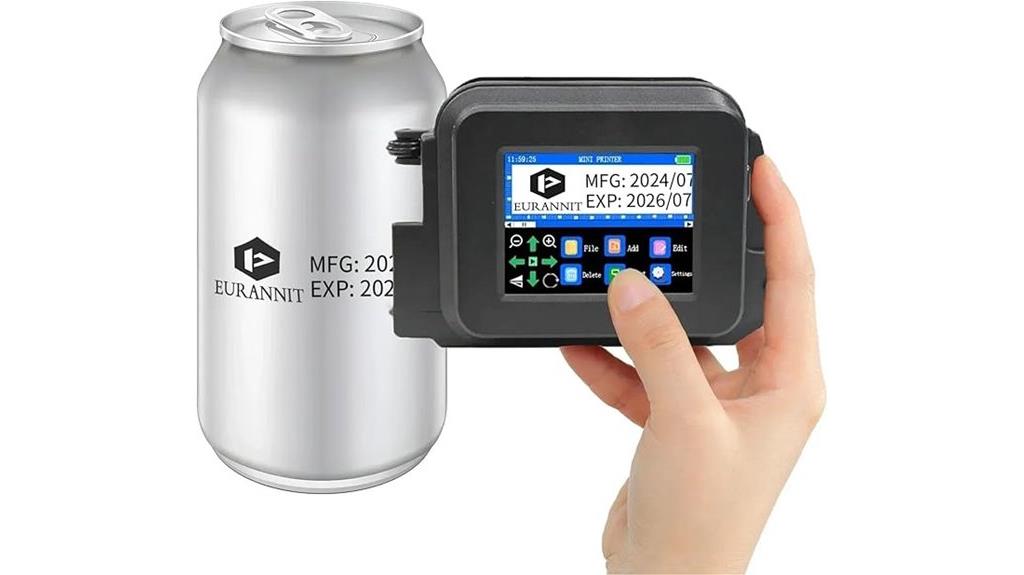
If you need a portable solution for on-the-spot coding and marking, the XMINI Handheld Inkjet Printer stands out as an excellent choice. Weighing just 1.1 pounds, it features a compact design with a durable 2.4-inch touchscreen for easy content editing in multiple languages. It can print text, barcodes, logos, and images on various surfaces like metal, plastic, and cardboard, even on curved or uneven objects. Powered by a rechargeable 2000 mAh battery, it supports high-resolution printing up to 600 DPI and quick-drying ink. Its versatility and portability make it ideal for industrial and office environments requiring precise, on-the-fly markings.
Best For: professionals and small businesses needing portable, on-the-spot coding and marking on various surfaces in industrial or office settings.
Pros:
- Lightweight and compact design for easy handling and portability
- Supports high-resolution printing up to 600 DPI with quick-drying, waterproof ink
- Capable of printing on curved and uneven surfaces, including metals, plastics, and cardboard
Cons:
- Limited maximum print height of 12.7mm may restrict larger markings
- Battery life may require frequent recharging during extensive use
- Limited to 1-5 lines of printing, which may not suit more complex or larger labeling needs
Mini Handheld Inkjet Printer Gun with 42ml Ink Cartridge
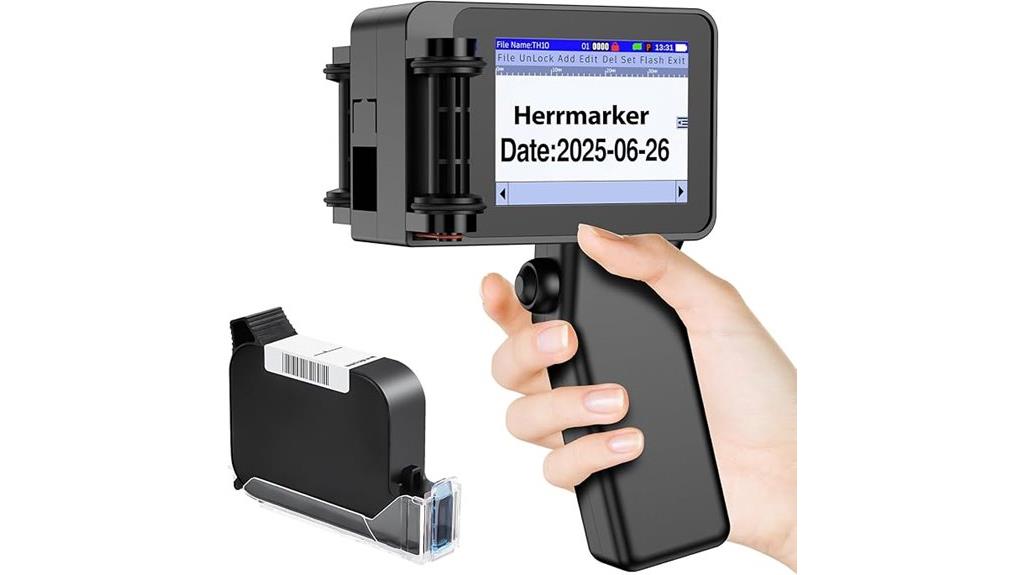
The Mini Handheld Inkjet Printer Gun with 42ml Ink Cartridge stands out for its portability and versatility, making it an ideal choice for professionals needing on-the-go marking solutions. Its lightweight design and 3.2-inch HD touchscreen enable quick, intuitive operation, supporting printing of QR codes, barcodes, dates, logos, and batch numbers on various surfaces like metal, glass, plastic, and curved objects. The quick-drying black dye ink ensures sharp, clear prints at up to 60 ppm, with adjustable print height and multi-line capability. Perfect for manufacturing, logistics, and retail, it combines ease of use with reliable performance, enhancing efficiency in any professional setting.
Best For: professionals in manufacturing, logistics, retail, and DIY enthusiasts seeking portable, high-quality marking solutions on various surfaces.
Pros:
- Portable and lightweight design for easy on-the-go use
- Supports a wide range of surfaces including curved and irregular objects
- Fast, sharp printing with adjustable height and multi-line capability
Cons:
- Inconsistent print quality reported by some users on certain materials
- Touch screen responsiveness issues can occur over time
- Ink may not adhere well to non-writable or non-porous surfaces, requiring careful surface preparation
RICOH IM C2000 Color Laser Multifunction Copier
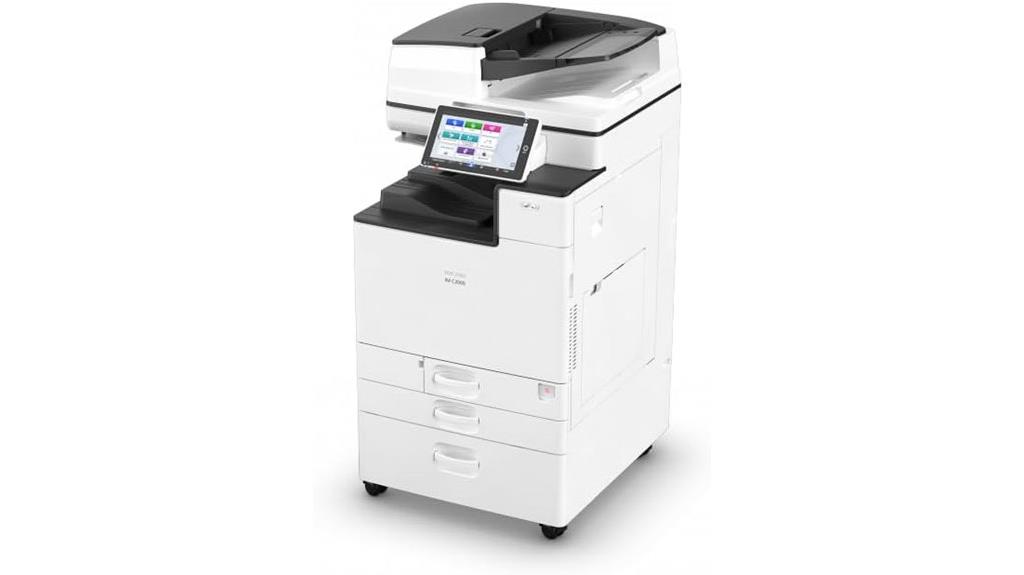
Designed for busy office environments, the RICOH IM C2000 Color Laser Multifunction Copier excels with its high-speed printing and versatile features, making it an excellent choice for teams needing reliable, all-in-one document management. It prints up to 20 ppm with crisp 1200 x 1200 dpi resolution, supporting color and black-and-white tasks. With a large input capacity of 2,300 sheets, duplex printing, and versatile media support, it boosts productivity. Connectivity options like WiFi and USB ensure seamless workflow integration. Compact and lightweight, it fits well in any office space, offering a dependable solution for printing, copying, scanning, and optional faxing.
Best For: busy office teams seeking a reliable, all-in-one color laser multifunction copier with high-speed printing and versatile media support.
Pros:
- Fast printing speed of up to 20 ppm with crisp 1200 x 1200 dpi resolution
- Large input capacity of 2,300 sheets and duplex printing for increased productivity
- Compact, lightweight design with flexible connectivity options like WiFi and USB
Cons:
- Limited to 90-day limited warranty, which may not cover long-term issues
- Only one paper tray may require frequent refilling for high-volume printing needs
- As a renewed product, it may have pre-existing wear or minor cosmetic imperfections
Tina2 Mini 3D Printer for Kids
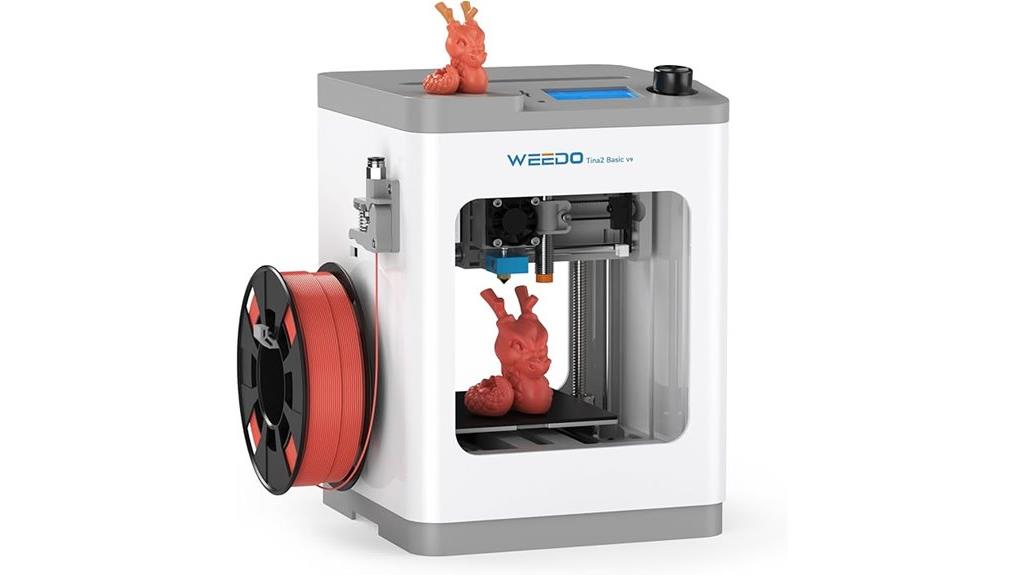
For parents and educators seeking an easy-to-use 3D printer for kids, the Tina2 Mini stands out with its plug-and-play setup and auto-leveling feature. Fully assembled and requiring no tools, it’s perfect for beginners and educational settings. Its compact size and user-friendly LCD interface make operation straightforward, with quick start instructions and minimal calibration needed. The semi-enclosed design ensures safety, while the flexible magnetic bed simplifies model removal. Capable of producing detailed, reliable prints with 0.1mm precision, it’s ideal for small projects, prototypes, and creative exploration. Overall, the Tina2 Mini offers a safe, accessible, and effective entry into 3D printing for young users.
Best For: parents, educators, and beginners seeking a safe, easy-to-use 3D printer for kids and educational purposes.
Pros:
- Fully assembled and plug-and-play, no tools required for setup
- Auto-leveling and safety features like semi-enclosed design and hotend cover
- Compact size with high reliability and good print quality for small projects
Cons:
- Lacks active cooling fans, which may affect print quality with certain materials
- No heated bed, limiting adhesion options for some filament types
- Built-in stepper motors produce noticeable noise during operation
High Precision 3D Printer for Kids and Beginners
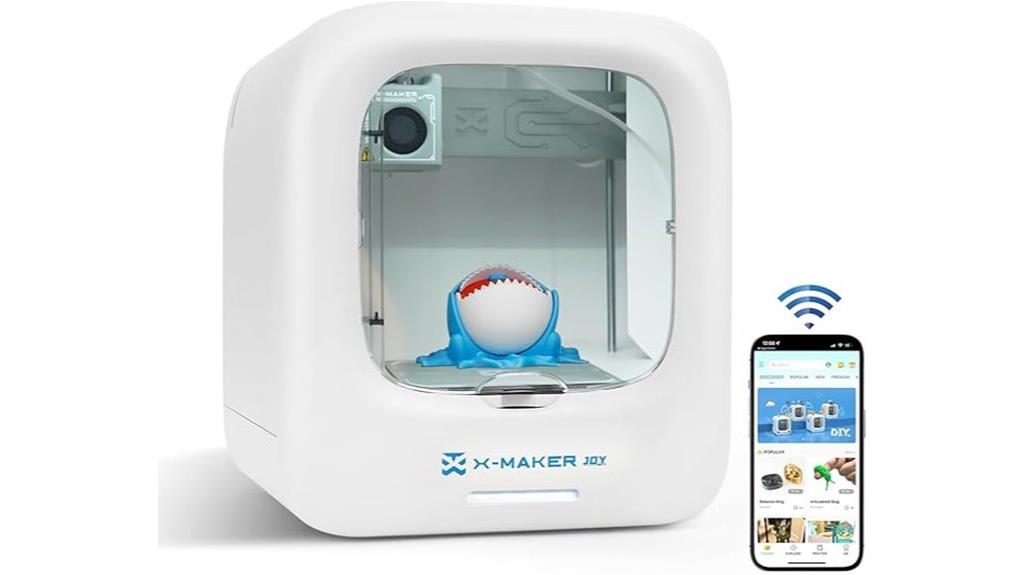
Aowei’s High Precision 3D Printer stands out as an ideal choice for kids and beginners thanks to its impressive 0.05mm resolution and user-friendly features. Its plug-and-play setup, automatic leveling bed, Wi-Fi connectivity, and app control make it accessible for novices. The enclosed design allows for easy external customization, turning the printer into a creative canvas. With a quick-change nozzle system and detailed tutorials, maintenance is straightforward. Compact and lightweight, it fits perfectly in homes or classrooms. Overall, this printer combines high-quality output with simple operation, making it perfect for inspiring young makers and easing beginners into 3D printing.
Best For: beginners, children, and families seeking an easy-to-use, high-precision 3D printer for educational and creative projects.
Pros:
- High resolution of 0.05mm ensures detailed and crisp prints.
- User-friendly features like automatic bed leveling, Wi-Fi connectivity, and app control simplify operation.
- Enclosed design and DIY customization options foster creativity and personalization.
Cons:
- Potential hotend dislodgement during long-distance transport requires reattachment.
- Limited to single-color printing, which may restrict complex multi-color projects.
- Some users may face challenges with firmware updates or filament loading procedures.
Factors to Consider When Choosing SLA Printers for Microfeatures
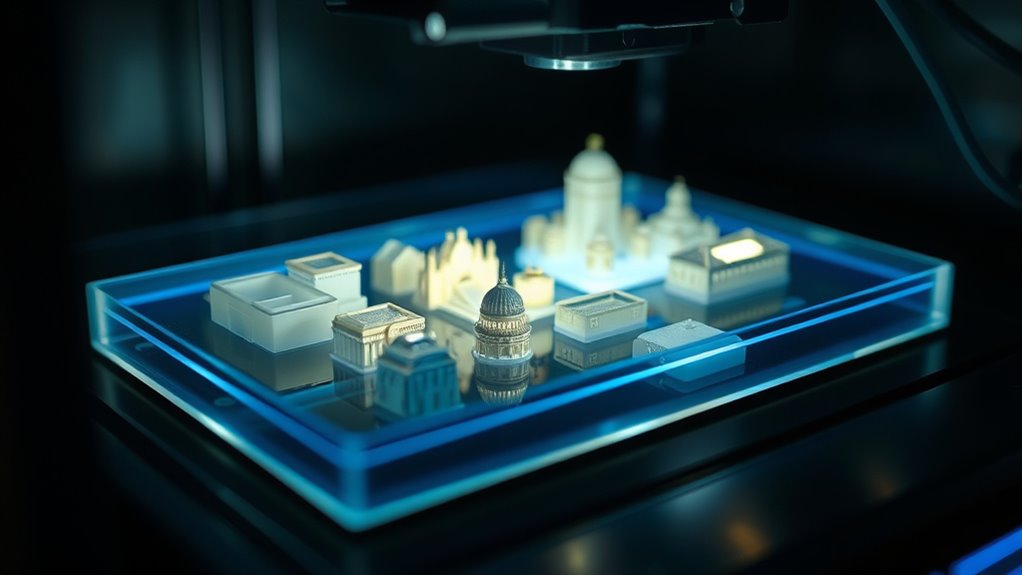
When choosing an SLA printer for microfeatures, I focus on resolution precision levels and layer thickness options to guarantee detail accuracy. I also consider build volume limits and print speed efficiency to meet project needs without sacrificing quality. Finally, resin compatibility types are vital to find the right materials for specific applications.
Resolution Precision Levels
Choosing the right SLA printer for microfeatures hinges on understanding resolution precision levels, as these directly impact the detail and accuracy of small-scale parts. Typically, microfeature printing requires a minimum resolution of 25 to 50 microns to capture fine details effectively. For even greater precision, printers with 10 to 25-micron resolution enable the creation of extremely detailed features, essential for intricate applications. Resolution is measured in microns, with lower numbers indicating finer layer thickness and higher detail. The achievable resolution depends on factors like the LCD or DLP chip size, optical system, and laser spot size. To guarantee microfeature accuracy, look for SLA printers with adjustable layer heights and proven high-resolution capabilities, which are essential for precision manufacturing.
Layer Thickness Options
Layer thickness options are a essential factor in selecting an SLA printer for microfeatures, as they directly influence the level of detail and surface quality of the final print. SLA printers typically offer settings from as low as 25 microns to 100 microns, giving you flexibility between high detail and faster production. Thinner layers, around 25–50 microns, produce highly detailed microfeatures with smooth surfaces, which is critical for intricate models. Thicker layers, like 75–100 microns, can reduce print times but may sacrifice resolution, potentially blurring fine details. Choosing the right layer thickness depends on balancing your need for precision against time constraints. Many SLA printers allow customizable options, so you can optimize settings based on your specific project requirements.
Build Volume Limits
Selecting an SLA printer for microfeatures requires careful attention to build volume limits, as these directly impact the size and complexity of your projects. Most micro-focused SLA printers have small build volumes, often under 2 inches (50mm) in height, to maintain high resolution and detail. Larger build volumes can reduce accuracy because of increased resin volume and curing inconsistencies, which can compromise tiny feature fidelity. It’s vital to match the printer’s build volume to your smallest intended models, avoiding waste and resizing issues. Additionally, build volume limits determine the maximum size of micro-scale parts you can produce in a single print without splitting or assembly. If you need multiple microcomponents, consider a slightly larger volume, but be aware that this may affect resolution and detail.
Print Speed Efficiency
When evaluating SLA printers for microfeatures, print speed plays a crucial role in overall efficiency, but it’s important to strike the right balance. Faster printers can reduce project times considerably, but overly rapid curing may sacrifice detail and accuracy. Achieving ideal speed involves balancing layer exposure time and resin curing parameters to prevent defects or loss of fine features. High-speed SLA printers often use more powerful light sources and advanced motion control systems, which can increase cost and complexity. For microfeatures, adjustable print speed settings are essential, allowing you to fine-tune the process for the best resolution without sacrificing efficiency. Ultimately, choosing a printer that offers flexibility in speed control ensures you can meet both quality and productivity demands effectively.
Resin Compatibility Types
Choosing the right resin compatibility for SLA printers is essential to achieve precise microfeatures, as different resin chemistries and formulations can substantially impact the quality of your print. Some printers support standard resins, while others are tailored for specialized types like castable, dental, or biocompatible resins, each requiring specific compatibility. Resin chemistry—such as acrylate, epoxy, or urethane-based—affects curing parameters and material properties, influencing layer adhesion and detail resolution. Compatibility also depends on viscosity and curing wavelength, which must match the printer’s light source and exposure settings for ideal results. Additionally, some SLA printers work exclusively with proprietary resins, while others accept third-party or custom formulations, offering greater flexibility but also requiring careful verification of material specifications aligned with your application.
Software Compatibility Ease
The software compatibility of an SLA printer can greatly influence how smoothly your microfeature projects come together. I look for slicing software that works seamlessly with my preferred design programs like Chitubox, Lychee, or Formlabs PreForm, as this streamlines my workflow. It’s essential that the printer supports common file formats such as STL, OBJ, or CAD files, ensuring easy integration into my existing design pipeline. I also check if the software offers features like automatic support generation, layer preview, and resin curing simulation—these tools simplify complex microfabrication. Compatibility with my operating system (Windows, Mac, Linux) and regular updates for bug fixes and new features are vital. User-friendly interfaces and tutorials help me reduce the learning curve, making precise microfeature printing more straightforward.
Maintenance Requirements
Regular maintenance is vital for maintaining the precision of SLA printers used for microfeatures, as neglecting it can lead to print failures and degraded detail quality. I recommend cleaning the resin vat, build platform, and optical components regularly to prevent resin buildup that can compromise accuracy. Checking and replacing the resin vat film or FEP sheet every few hundred hours ensures proper layer adhesion and minimizes failures. Precise calibration of the laser or DLP projector is essential; periodic adjustments help sustain the accuracy of tiny, detailed features. Additionally, filtering and replacing resin frequently prevents contamination and resin aging, which can cause defects. Finally, inspecting and cleaning optical paths—mirrors and lenses—regularly guarantees excellent light delivery, preserving the high resolution and fine detail that microfeature printing demands.
Cost and Value
Have you ever considered how the initial cost of an SLA printer impacts its long-term value for microfeature work? Higher-resolution models tend to be more expensive but deliver the fine detail essential for microfeatures. The overall value hinges on balancing the purchase price with ongoing costs like resin, replacement parts, and maintenance. Budget-friendly printers might save money upfront but often compromise on stability or light source quality, which can reduce microfeature precision and increase costs over time. Premium models, however, usually include features like automated calibration and superior optics that enhance detail and justify their higher price. When evaluating cost and value, consider the total ownership cost—resins, upgrades, and maintenance—so you choose a solution that delivers consistent microfeature accuracy without hidden expenses.
Frequently Asked Questions
How Does Resin Type Affect Microfeature Resolution?
Resin type directly impacts microfeature resolution because different resins have varying viscosities, curing properties, and transparency. I’ve found that high-quality, low-viscosity resins cure more precisely, capturing finer details without distortion. Some resins also resist warping and shrinkage better, ensuring microfeatures stay true to design. So, choosing the right resin with ideal curing characteristics can greatly improve your print’s resolution and accuracy at the micro-level.
What Post-Processing Steps Are Essential for Micro-Scale SLA Prints?
They say “a chain is only as strong as its weakest link,” and that’s true for micro-scale SLA prints too. Post-processing is vital; I always start with careful cleaning using isopropyl alcohol to remove residual resin. Then, I cure the print under UV light to strengthen it. Finally, I gently sand or trim any excess resin or support marks, ensuring every tiny detail stays sharp and precise.
Can SLA Printers Handle Multi-Material Micro-Fabrication?
Yes, SLA printers can handle multi-material micro-fabrication, but it’s challenging. I’ve found that using specialized multi-resin systems or dual-nozzle setups helps attain complex micro-scale structures in different materials. Precise alignment and careful calibration are essential to prevent cross-contamination and verify accuracy. While not all SLA printers support multi-material fabrication out of the box, with the right equipment and technique, it’s definitely possible.
How Does Layer Thickness Impact Detail Accuracy in Small Features?
Layer thickness is like the brushstroke in a painting; thinner layers reveal finer details. When I use smaller layer heights, I see crisp, intricate microfeatures emerge with precision, almost like tiny sculptures carved from glass. Thinner layers reduce the risk of blurring or loss of detail, allowing me to achieve exceptional accuracy in small features. It’s the key to revealing microfabrication’s full potential, revealing every delicate nuance with clarity.
What Maintenance Is Required for Optimal Microfeature Printing?
To keep my SLA printer performing at its best for microfeatures, I regularly clean the resin vat and build platform to prevent debris buildup. I check and replace the resin filters as needed, make sure the laser is properly calibrated, and keep the optics clean. Additionally, I follow a consistent maintenance schedule, including firmware updates and inspecting for wear, to maintain high precision and detail in every tiny feature I print.
Conclusion
Choosing the right SLA printer for microfeatures is essential, and I hope this list helps you find your perfect match. Remember, the devil is in the details, and with the right tools, you can achieve precision like never before. Don’t settle for less when the tiniest features can make the biggest difference. Trust your instincts, do your homework, and soon you’ll be creating miniature masterpieces that truly stand out.
